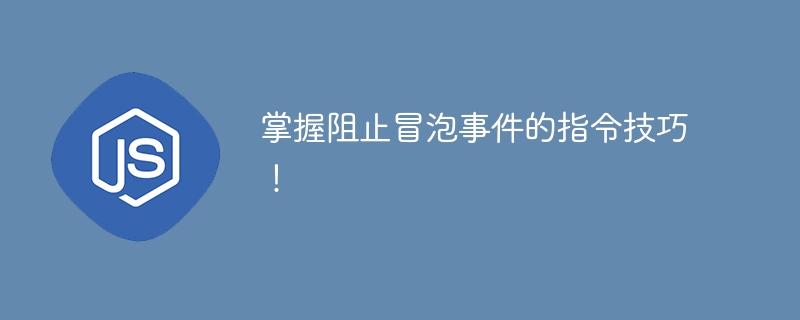

Master the command skills to prevent bubbling events!
When we use electronic devices, we often encounter triggers of various events. Some events are like bubbles, popping up from one place and then spreading to other places, affecting our normal operations. In order to avoid the spread of bubbling events, we need to master some command skills. This article will introduce some common command techniques to prevent bubbling events to help readers better deal with such problems.
First, let us understand what a bubbling event is. In computer programming, a bubbling event means that when an element triggers an event, the event is passed to its parent element, and then to higher-level parent elements until it is passed to the root element or the event is blocked. . This method of event delivery allows us to handle the same event on elements at different levels.
However, sometimes we don’t want the event to continue to be passed upwards, but we want to be triggered only on the current element. In this case, we need to use the command technique to prevent bubbling events. Here are some common directive techniques:
In addition to the command techniques mentioned above, there are some other methods that can help us prevent bubbling events. For example, you can use event.stopImmediatePropagation() to stop the execution of other event handling functions on the current element, or use the useCapture parameter of the addEventListener() method to handle the event in the capture phase to prevent the event from continuing to bubble up.
However, although the above command techniques can help us prevent bubbling events, not all bubbling events need to be blocked. Sometimes, we need events to be passed on elements at different levels to achieve some specific functions. Therefore, when using these command techniques, you need to carefully judge whether you really need to prevent bubbling events.
To sum up, mastering the command skills to prevent bubbling events is very important for us to better handle event triggering on electronic devices. By using methods such as stopPropagation(), return false, and preventDefault(), we can prevent event delivery and default behavior in a targeted manner. However, it is necessary to judge whether bubbling events need to be blocked based on the specific situation, so as not to affect the normal use of other functions. We hope that the command techniques provided in this article can help readers better deal with bubbling events and achieve a better experience when using electronic devices.
The above is the detailed content of Master the command skills to stop events from bubbling up!. For more information, please follow other related articles on the PHP Chinese website!
 What problems can js event bubbling solve?
What problems can js event bubbling solve?
 pscs5 installation serial number
pscs5 installation serial number
 Vue parent component calls the method of child component
Vue parent component calls the method of child component
 Usage of distinct in SQL
Usage of distinct in SQL
 The difference between css3.0 and css2.0
The difference between css3.0 and css2.0
 What does ping mean?
What does ping mean?
 How to buy and sell Bitcoin in China
How to buy and sell Bitcoin in China
 How to solve unrecognized usb device
How to solve unrecognized usb device
 Where should I fill in my place of birth: province, city or county?
Where should I fill in my place of birth: province, city or county?




